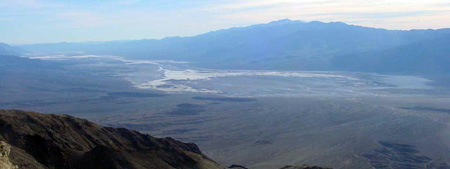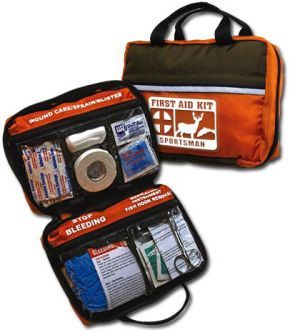Cold Weather Camping
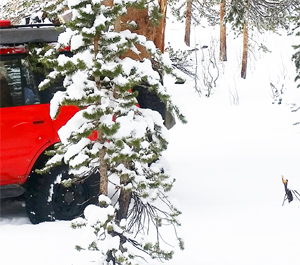
Nice Camp site
(Click picture for a larger image.)
|
At this time of year, thoughts often turn to escaping to sunny, sandy beaches. Some folks, however, enjoy
romping in the snow.
They brave the elements, and camp out in the wild. One benefit is that you can have the park or wildlife area practically to yourself.
Just as you need to account for the extreme heat of summer, so should you plan for the challenges of camping in snow and cold.
Start by checking the forecast. You should know going in what to expect. Never camp alone, and always tell someone where you’re going and when you’ll be back.
Prepare for the worst so you’re not taken by surprise. (And if a bad storm is predicted, stay home.)
Clothing
The most important factor is to stay warm and dry. Frostbite and hypothermia aren’t just annoyances. They can be killers.
Needless to say, you’ll need warm clothing and lots of it. Clothing that incorporates Gore-Tex (or similar fabric) is very useful. You need to wick out as much sweat as possible. Damp clothing can chill you quickly, and bring on hypothermia.
Outercoats should have a nylon shell to break the wind. Thinsulate is a great insulating material for coats and gloves.
Layer your clothing during the day. Make sure there’s some give, though. If you feel constricted, the fabric will be packed so tightly that it’ll lose some insulating ability.
Having extra clothing also ensures that you can change into dry stuff at the end of the day.
Look for sturdy boots. Sorel is a good brand, but there are others. You’ll want rubber soles with good traction. Leather uppers are nice, but treat with a sealant.
Tent
I recommend a 4-season tent. The walls on these are solid material to block wind and shed snow. I prefer those with a full fly over the tent as well.
Unbelievable, it makes for a better desert tent too. The fly creates shade and the combination of 2 walls keeps blowing sand out.
Look for a model that has a vestibule. That’s where you’ll store your outerwear and boots.
A vestibule, provides a transition area to reduce the snow you track into the main tent.
It provides more room for sleeping, and your bedding and dry clothing won’t get wet.
Incidentally, never sleep in clothes you’ve been working in. They will be damp with perspiration, which means you’ll be uncomfortable all night.
Set aside dry clothing for sleeping. That includes socks, heavy pajamas (or sweat shirt and sweat pants) and a warm hat.
Prior to setting up, pack down the snow for a firm base. Create a berm around the sides for wind break, and remember to face the front door away from the wind.
A good sleeping bag is a must. If you can’t find one rated to the proper temperature, take along two. You can stuff one inside the other.
Understand that manufacturers take liberty with the temperature ratings on their products.
Assume your boots, sleeping bag, and clothing won’t really keep you comfortable at the manufactures rated temperature.
That’s why you pack heavy clothing, and even feet and hand warmers.
Use a foam mattress or blankets as insulation under your sleeping bag.
Termarest mattresses work but the $20 / $30 6 inch type air mattresses don’t provide much insulation, because the air inside circulates too much.
Dead air space is a great insulator but it has to be dead (i.e. not circulate).
Tent heaters are nice, however be careful. Today’s models are small and easy to use.
The Little Buddy by Mr Heater, for example, uses the standard 1 lb. propane cylinder. The manufacturer claims it can heat up to 100 square feet.
Do not leave the heater running all night. Even though it has an oxygen sensor and a very sensitive tip-over switch,
I wouldn’t want to take the risk of fire or CO poisoning. Run the heater before you snuggle into your tent, then again when you wake up.
If you are on a hunting trip, store guns and outerwear outside but away from snow (in the vestibule or your vehicle).
A gun warming up will generate condensation if brought inside.
Any snow on your outer clothing won’t melt if left in the cold, so you’re not likely to get damp (at least from that).
Also, don’t leave gear, including shovels, axe, etc. outside. They could get buried in the snow. Store those in your vehicle.
Cooking
Cooking, as you can imagine, presents its own challenges. Interestingly, the cold temps can work against you.
To prevent (or minimize) freezing, keep fresh food it in a cooler. (Secure during the day to thwart critters.)
You may want to stash the cooler in your vehicle overnight.
Use wooden or plastic utensils as much as possible. Metal objects get blasted cold in the winter.
Propane is fine for most winter applications, but it is sluggish in severe cold. If you anticipate those temps, pack a stove that runs on white gas.
Vehicle
This is a good time to recheck the vitals. Inspect your tires. Rotate and replace as needed. Test the battery and windshield wipers; replace if necessary.
Check your antifreeze: Is it still at full strength? Are you low on windshield washer fluid? Make sure you have a survival kit and tire chains (if applicable).
Room permitting, pack a snow shovel—small models are available—and ice pick. Orange spray paint comes in handy for marking the snow in the event of an emergency.
Remember to include a fire-starter kit. Fill a baggie with matches and cotton balls coated with Vaseline.
Communication
Keep your cell phone charged up. Before you leave, identify the frequencies of the ham radio repeaters in the area you are visiting.
Make a habit of listing to the NOAA weather broadcasts each day.
If you’ll be in a really remote area, consider a Sat phone or other device discussed in
"Communications equipment is critical for off-road driving.”
Mother Nature puts on a new performance during winter. For those hardy enough, camping can be very enjoyable and rewarding. As with any other four wheeling experience, preparation is key.
--------------------------------------------------------------------------------
Related Articles from Badlands Off-road Adventures
|
Did you miss the previous article?
Upcoming Events
(click on the link for details)
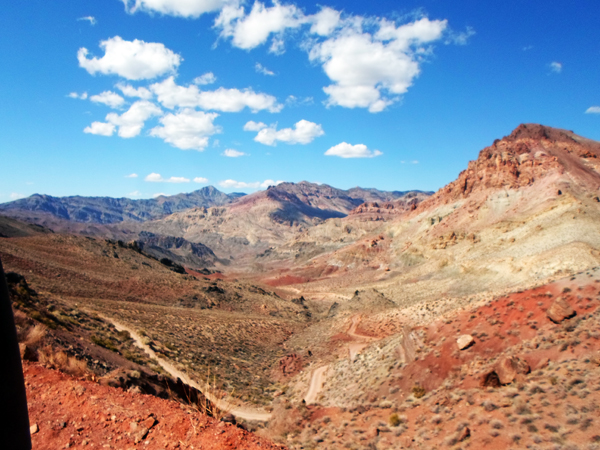
Red Pass, Death Valley - looking NW in the Grapevine Mountains
(Click picture for a larger image.)
|
Summary of upcoming events.
|
Sand Clinic February 28, 2015
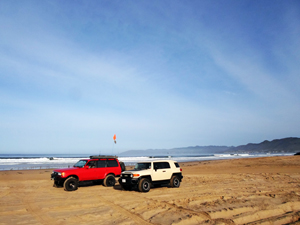
On Pismo Beach in California
(Click picture for a larger image.)
|
If you have been waiting for the next Sand Driving Clinic, put it on your calendar for February 21st and sign up now.
This day-long clinic will expose you to a variety of driving conditions and levels of difficulty.
Driving on sand is challenging and different than dirt, so we’ll progress slowly as you learn the proper techniques.
As your confidence grows, you will master increasingly more challenging dunes.
Along the way you will be exposed to the beauty of SVRA and the thrill of the windswept dunes.
This is a rare opportunity to cruise the only beach in California open to vehicles.
More details...
Register for the Sand Clinic using this link.
http://4x4training.com/calendar/calendar.php#SandPismo
|
##########################
Death Valley April 08-11
This is a 4 day trip on the back roads in Death Valley.
We will drive the Panamint Mountains, drive past Badwater Basin (lowest spot in North America),
visit Chloride Ghost town, Titus Canyon, check out Ubehebe Crater, Teakettle junction, The Race Track & Lippencott Mine Road,
camp at the Warm Springs and leave via Steal Pass up to the high meadows, then take Dedeckera Canyon
down to the Eureka Sand Dunes. All four days will see some light to moderate 4-wheeling.
Much of the trip is quite remote with random or no cell service. We don't plan to stop at tourist sights you can get to in a passenger car.
Check out the details and sign up on the website:
http://www.4x4training.com/Adventures/Deathvalley.html
August 2013 Off-Road Adventures Magazine: Death Valley Excursion by Denis Snow
You can register directly at
http://www.4x4training.com/calendar/calendar.php#Deathvalley
|
##########################
Wilderness First Aid Course April 16 & 17, 2016
If you are interested in taking a Wilderness first Aid Course (WFA), Badlands Off-Road Adventures is sponsoring a 2 day class in April.
We engage a professional medical instructor from Wilderness Medical Associates, the certifying agency.
Badlands Off-Road Adventures is sponsoring the Wilderness Advanced First Aid (WFA) clinic because we feel everyone should be prepared when they go outdoors. This will be the best first aid course you have ever taken. That is unless you go on to the Wilderness First Responder Class.
The WFA clinic will provide you with skills, knowledge and training to handle life threatening medical emergencies and allows you to be better prepared to protect your family in an emergency. Wilderness First Aid is a two day immersion into general medical concepts and Basic Life Support skills. This course teaches what to do with a medical emergency when help is miles away and calling 911 isn’t an option.
“The Wilderness First Aid was one of the MOST USEFULL clinics I have ever attended, due in large part to the effort you and Josh put in to make it all possible. "
Joe de Kehoe.
The clinic will be held April 16 & 17, 2016 at the Hungry Valley State Vehicle Recreation Area (SVRA) near Gorman, CA. Please reserve the dates on your calendar or sign up today. (Note – you must be 18 years old to take the clinic.)
If you are interested follow these links.
More Details...
You can register directly at
http://www.4x4training.com/calendar/calendar.php#WFA
|
Winch Recovery Bandana & Winching DVD
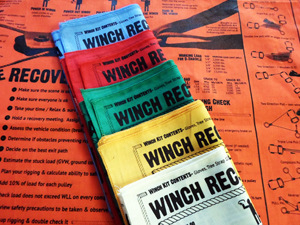
Click for higher resolution image
|
We have our new stock with many new colors (Red, Orange, Green, and Blue) on hand.
The Bandana is packed full of useful information and is a quick reference in the field when no DVD player is available."
The Bandana layout follows the “Vehicle Recovery Plan” with pathways to more detail.
A unique section of the Bandana, gives the steps for a “Winch Rigging Check: Walk through” so that you verify every element of the rigging before you commit to the pull.
Stuff this in your recovery kit and you will always be ready!
Pick up or order the Winching DVD too!
There is no substitute for hands on training. If you can, sign up for one of Badlands Off-Road Adventure’s Winching Clinics.
Warning – the Bandana and DVD are not a substitute for proper training and use of quality equipment that is used within the bounds of their safe working load.
We advise you to use the information provided in both the Winching Recovery Bandana and the "Basic to Advanced Winching and Recovery DVD" at your own risk.
We cannot control the quality and specifications of the equipment used and the methods actually employed.
|
Winch Recovery Bandana Order Button
|
Order a Basic to Advanced Winching & Recovery DVD too!
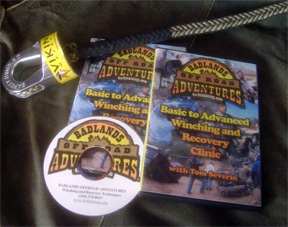
(Click picture for more details)
|
|
I hope to see you on the trails!
Tom Severin, President
Badlands Off Road Adventures, Inc.
4-Wheel Drive School
310-613-5473
http://www.4x4training.com
Make it Fun. Keep it Safe.
If you find this information valuable, please pass it on to a friend. You can forward them the email.
If you received a forwarded copy of this newsletter and would like to subscribe for yourself, go to:
www.4x4training.com/contacts.html
and follow the instructions to join our mail list.
Want To Use This Article In Your Magazine, E-Zine, Club Newsletter Or Web Site?
You are welcome to use it anytime, just be sure to include the following author/copyright information:
Tom Severin, 4x4 Coach, teaches 4WD owners how to confidently and safely use their vehicles to the fullest extent in difficult
terrain and adverse driving conditions.
Visit www.4x4training.com to develop or improve your driving skill.
Copyright 2016, Badlands Off-Road Adventures, Inc.
|
|



